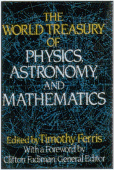
The Art of Discovery
by Horace Freeland Judson
 |
The Art of Discovery
by Horace Freeland Judson
|
Science is our century's art.Nearly four hundred years ago,when modern science was just beginning,Francis Bacon wrote that knowledge is power.Yet Bacon was not a scientist.He wrote as a bureaucrat in retirement.His slogan was actually the first clear statement of the promise by which,ever since,bureaucrats justify to each other and to king and taxpayer the spending of money on science.Knowledge is power;today we would say,less grandly,that science is essential to technology.Bacon's promise has been fulfilled abundantly, magnificently.The rage to know has been matched by the rage to make.Therefore - with the proviso,abundantly demonstrated,that it's rarely possible to predict which program of fundamental research will produce just what technology and when - the promise has brought scientists in the Western world unprecedented freedom of enquiry.Nonetheless,Bacon's promise hardly penetrates to the thing that moves most scientists.Science has several rewards,but the greatest is that it is the most interesting, difficult,pitiless,exciting,and beautiful pursuit that we have found. Science is our century's art.
The takeover can be dated more precisely than the beginning of most
eras:Friday,June 30,1905,when
Albert Einstein,a clerk in the Swiss patent
office in Bern,submitted a thirty-one-page paper,"On the Electrodynamics
of Moving Bodies," to the journal Analen der Physik.No poem,no
play,no piece of music written since then comes near the theory of relativity
in its power,as one strains to apprehend it,to make the mind tremble with
delight.Whereas fifty years ago it was often said that hardly twoscore people
understood the theory of relativity,today its essential vision,as Einstein
himself said,is within reach of any reasonably bright high school
student - and that,too,is characteristic of the speed of assimilation
of the new in the arts.
Consider also the molecular structure of that stuff of the gene,the celebrated double helix of deoxyribonucleic acid.This is two repetitive strands,one winding up,the other down,but hooked together,across the tube of space between them,by a sequence of pairs of chemical entities - just four sorts of these entities,making just two kinds of pairs,with exactly ten pairs to a full turn of the helix.It's a piece of sculpture.But observe how form and function are one.That sequence possesses a unique duality:one way,it allows the strands to part and each to assemble on itself,by the pairing rules,a duplicate of the complementary strand;the other way,the sequence enciphers,in a four-letter alphabet,the entire specification for the substance of the organism.The structure thus encompasses both hereditary and embryological growth,the passing-on of potential and its expression.The structure's elucidation,in March of 1953,was an event of such surpassing explanatory power that it will reverberate through whatever time mankind has remaining.The structure is also perfectly economical and splendidly elegant.There is no sculpture made in this century that is so entrancing.
If to compare science with art seems - in the last quarter of this century - to undervalue what science does,that must be,at least partly,because we now expect art to do so little.Before our century,everyone of course supposed that the artist imitates nature.Aristotle had said so;the idea was obvious,it had flourished and evolved for two thousand years;those who thought about it added that the artist imitated not just nature as it accidentally happens,but by penetrating to nature has it has to be.Yet today that describes the scientist."Scientific reasoning," Medawar also said,"is a constant interplay or interaction between hypotheses and the logical expectations they give rise to:there is a restless to-and-fro motion of thought,the formulation and reformulation of hypotheses,until we arrive at a hypothesis which,to the best of our prevailing knowledge,will satisfactorily meet the case." Thus far,change only the term "hypothesis" and Medawar described well the experience of the painter or poet has of his own work."Scientific reasoning is a kind of dialogue between the possible and the actual,between what might be and what is in fact the case," he went on - and there the difference lies.The scientist enjoys the harsher discipline of what is and is not the case.It is he,rather than the painter or poet in this century,who pursues in its stringent form the imitation of nature.
Many scientists - mathematicians and physicist especially - hold that beauty in a theory is itself almost a form of proof.They speak,for example of "elegance".Paul Dirac predicted the existence of antimatter ( what would science fiction be without him?) several years before any form of it was observed.He won a share in the Nobel Prize in physics in 1933 for the work that included that prediction."It is more important to have beauty in one's equations than to have them fit experiment," wrote Dirac many years later."It seems that if one is working from the point of view of getting beauty in one's equations,and if one has really a sound insight,one is on a sure line of progress."
Here the scientist parts company with the artist.The insight must be sound.The dialogue is between what might be and what is in fact the case.The scientist is trying to get the thing right.The world is there.
And so are other scientists.The social system of science begins with the apprenticeship of the graduate student with a group of his peers and elders in the laboratory of a senior scientist;it continues to collaboration at the bench or the blackboard,and on to formal publication - which is a formal invitation to criticism.The most fundamental function of the social system of science is to enlarge the interplay between imagination and judgement from a private into a public activity.The oceanic feeling of well-being,the true touchstone of the artist,is for the scientist,even the most fortunate and gifted,only the midpoint of the process of doing science.
| Chaos | Quantum | Logic | Cosmos | Conscious | Belief | Elect. | Art | Chem. | Maths |